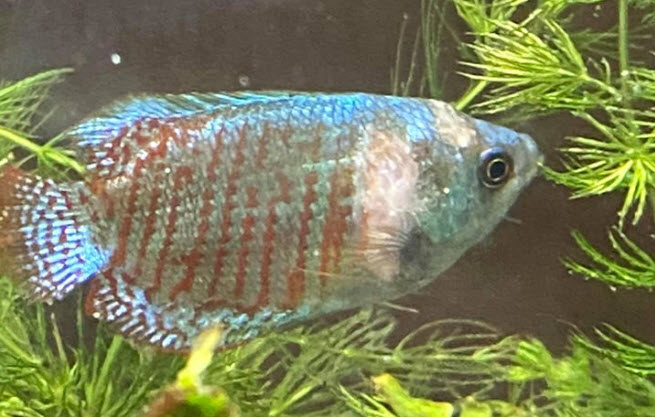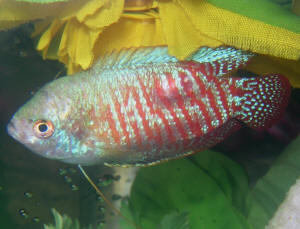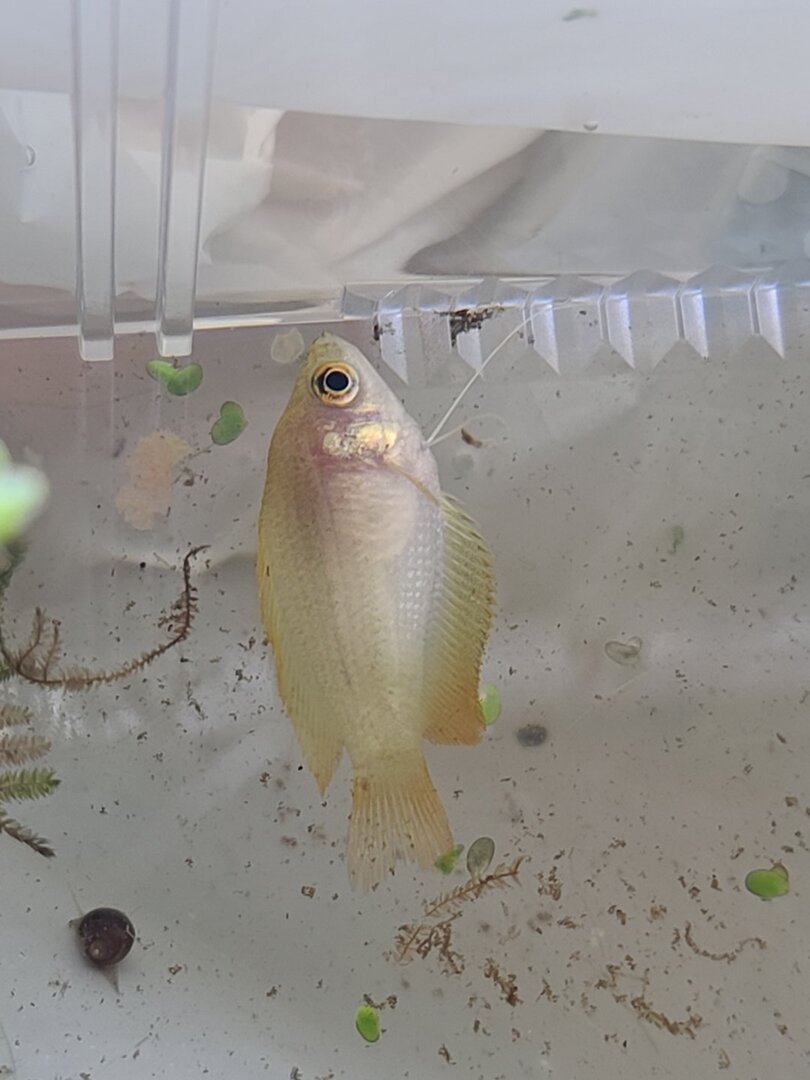Honey Gouramis can suffer from common fish diseases like Ich and fin rot. Poor water quality often leads to these health issues.
Honey Gouramis, known for their peaceful nature and vibrant colors, are a popular choice for aquarium enthusiasts. These small freshwater fish thrive in well-maintained tanks with stable water conditions. Despite their hardy nature, Honey Gouramis are susceptible to certain health problems.
Poor water quality and stress are major contributors to ailments like Ich, fin rot, and bacterial infections. Regular tank maintenance, proper diet, and monitoring water parameters can prevent most health issues. Observing your fish daily for signs of illness ensures timely intervention. By maintaining a clean and stress-free environment, you can help your Honey Gouramis lead healthy lives.
Introduction To Honey Gourami
The Honey Gourami is a popular fish for home aquariums. Known for its vibrant color and peaceful nature, it brings beauty to any tank. However, Honey Gouramis can face health problems if not cared for properly. This section will introduce you to this fascinating species and their basic care requirements.
Species Overview
The Honey Gourami, scientifically named Trichogaster chuna, is a small freshwater fish. They are native to India and Bangladesh. Their bright yellow-orange hue makes them easily recognizable. Males are more colorful than females.
- Size: Up to 2 inches
- Lifespan: 4-6 years
- Temperament: Peaceful
- Diet: Omnivorous
Basic Care Requirements
To ensure your Honey Gourami stays healthy, follow these basic care tips:
- Tank Size: Minimum 10 gallons
- Water Temperature: 72-82°F (22-28°C)
- pH Level: 6.0-7.5
- Diet: High-quality flakes, live or frozen food
- Tank Mates: Other peaceful fish
Water Quality
Maintain clean water. Use a good filtration system. Perform regular water changes.
Feeding
Feed them twice daily. Offer a varied diet for optimal health.
Behavior
Honey Gouramis are shy. Provide hiding spots with plants and decorations. Monitor their interactions with other fish to prevent stress.
| Parameter | Requirement |
|---|---|
| Tank Size | Minimum 10 gallons |
| Water Temperature | 72-82°F (22-28°C) |
| pH Level | 6.0-7.5 |
| Diet | High-quality flakes, live or frozen food |
| Tank Mates | Other peaceful fish |

Credit: aquariumscience.org
Identifying Health Problems
Honey Gouramis are peaceful and gentle fish. They need proper care to stay healthy. Observing them closely helps in spotting health issues early. This section helps you identify common health problems in Honey Gouramis.
Signs Of Illness
Watch out for visible signs of illness in Honey Gouramis. White spots, red sores, and discolored patches are common indicators. Also, check for fin rot and swollen eyes. A healthy Gourami should have clear, bright eyes. If the eyes look cloudy, there might be a problem.
| Symptom | Possible Cause |
|---|---|
| White Spots | Ich Infection |
| Red Sores | Bacterial Infection |
| Discolored Patches | Fungal Infection |
| Fin Rot | Poor Water Quality |
| Swollen Eyes | Popeye Disease |
Behavioral Changes
Behavioral changes are another sign of health problems. Healthy Honey Gouramis are active and swim around. If they start hiding or become less active, it might be a problem. Also, watch their eating habits. A sudden loss of appetite is a red flag.
- Less Activity: Could indicate stress or illness.
- Hiding Often: Might suggest discomfort or disease.
- Loss of Appetite: Often a symptom of illness.
Regularly monitor your Honey Gouramis. Quick detection of health issues can save their lives. Provide a clean tank, good food, and proper care to keep them healthy.
Common Diseases
Honey Gouramis are peaceful and beautiful fish. But they can face health problems. Understanding common diseases can help keep your fish healthy. Here are some common diseases that affect Honey Gouramis.
Ich (white Spot Disease)
Ich is a common disease in Honey Gouramis. It is caused by a parasite.
Symptoms:
- White spots on the body and fins
- Fish rubbing against objects
- Labored breathing
Treatment:
- Raise the water temperature
- Add aquarium salt
- Use a commercial Ich treatment
Prevention:
- Quarantine new fish
- Maintain good water quality
- Do not overcrowd the tank
Fin Rot
Fin Rot is another issue for Honey Gouramis. It is caused by bacteria.
Symptoms:
- Ragged and frayed fins
- Discoloration on the fins
- Fish swimming erratically
Treatment:
- Improve water quality
- Use antibacterial medications
- Isolate infected fish
Prevention:
- Keep the tank clean
- Avoid overfeeding
- Monitor fish for early signs

Credit: aquariumscience.org
Parasites In Honey Gourami
Parasites can be a major problem for Honey Gourami. These tiny invaders can cause significant health issues. It’s essential to understand the types, symptoms, and treatments to keep your fish healthy.
Types Of Parasites
Honey Gourami can be affected by various types of parasites. These parasites can live in different parts of their bodies.
| Type of Parasite | Description |
|---|---|
| Ichthyophthirius multifiliis (Ich) | Commonly known as white spot disease. Causes white spots on the skin. |
| Gyrodactylus | A type of skin fluke. Can cause severe irritation and damage to the skin. |
| Trichodina | These are ciliate protozoa. They attach to the fish’s skin and gills. |
Symptoms Of Infestation
Recognizing the symptoms of a parasitic infestation is crucial. Early detection can save your Honey Gourami from severe health issues.
- White Spots: Small white spots on the skin, indicating Ich infection.
- Scratching: Fish rubbing against objects to relieve irritation.
- Labored Breathing: Difficulty breathing due to gill parasites.
- Weight Loss: Unexplained weight loss may indicate internal parasites.
- Redness or Inflammation: Skin may appear red or swollen due to irritation.
These symptoms suggest a parasitic issue. Prompt action is necessary to treat the infestation and protect your fish.
Nutritional Deficiencies
Honey Gouramis are small, colorful fish. They need a balanced diet to stay healthy. Nutritional deficiencies can harm them. Let’s explore the effects of a poor diet and the essential nutrients they need.
Poor Diet Effects
A poor diet can cause many health issues in Honey Gouramis. They may become weak and lethargic. Poor diet can also lead to poor growth. In severe cases, fish may die.
- Weakness and lethargy
- Poor growth
- Increased susceptibility to diseases
- Potential mortality
Essential Nutrients
Honey Gouramis need a variety of nutrients. A balanced diet is crucial. Here are some essential nutrients they require:
| Essential Nutrients | Benefits |
|---|---|
| Proteins | Helps in growth and repair of tissues. |
| Fats | Provides energy and supports cell structure. |
| Vitamins | Boosts immune system and overall health. |
| Minerals | Strengthens bones and aids in various functions. |
Ensure their diet includes these nutrients. Feed them a mix of flakes, live, and frozen foods. This ensures they get a balanced diet.
Environmental Stress
Environmental stress is a common cause of health problems in Honey Gouramis. These delicate fish need specific conditions to thrive. Poor environments can make them sick.
Water Quality Issues
Water quality is crucial for Honey Gouramis. They need clean, well-oxygenated water. Poor water quality can lead to stress and illness.
Check the following factors to ensure good water quality:
- Temperature: Keep the water between 72°F and 82°F.
- pH Level: Maintain a pH between 6.0 and 7.5.
- Ammonia and Nitrite Levels: These should always be at 0 ppm.
- Nitrate Levels: Keep nitrates below 20 ppm.
Regular water changes help keep the tank clean. Change 20% of the water weekly.
Tank Mate Compatibility
Honey Gouramis are peaceful fish. They do well with similar peaceful tank mates. Aggressive fish can cause stress and injury to them.
Suitable tank mates include:
- Neon Tetras
- Cherry Barbs
- Harlequin Rasboras
- Corydoras Catfish
Avoid these aggressive tank mates:
- Betta Fish
- Large Cichlids
- Red-Tailed Sharks
Monitor interactions between fish. Separate any that cause stress or harm.
Preventive Measures
Honey Gouramis are beautiful and peaceful fish, but they require proper care to stay healthy. Preventive measures are crucial in ensuring their well-being. This section outlines the steps you can take to avoid common health problems in Honey Gouramis.
Regular Tank Maintenance
Maintaining a clean tank is essential for Honey Gourami health. Follow these steps to ensure your tank remains in top condition:
- Water changes: Perform weekly 20-30% water changes to keep the water fresh.
- Filter cleaning: Clean the filter media every month to remove debris and ensure proper filtration.
- Gravel vacuuming: Use a gravel vacuum to remove uneaten food and waste from the substrate.
| Task | Frequency |
|---|---|
| Water changes | Weekly |
| Filter cleaning | Monthly |
| Gravel vacuuming | Weekly |
Quarantine Procedures
Quarantine new fish to prevent the spread of diseases. Follow these steps for effective quarantine:
- Separate tank: Use a separate tank for new arrivals.
- Observation period: Keep new fish in quarantine for 2-4 weeks.
- Monitor health: Observe new fish daily for signs of illness.
This process helps protect your existing fish from potential health issues.
Treatment Options
Honey Gouramis are delicate fish. They can suffer from various health issues. It’s important to know the best treatment options. This will help you keep your fish healthy and happy. Below are effective treatments for common health problems.
Medications
Medications can treat many fish diseases. Some common ones include:
- Antibiotics: Useful for bacterial infections like fin rot and ulcers.
- Antifungals: Treats fungal infections that appear as white cotton-like spots.
- Antiparasitics: Effective against parasites like ich and flukes.
Always follow dosage instructions carefully. Overdosing can harm your fish. Use a quarantine tank for treatment. This helps to avoid spreading diseases.
Natural Remedies
Natural remedies can also be effective. They are safer for sensitive fish like Honey Gouramis. Common natural remedies include:
- Salt Baths: Useful for treating external parasites. Dissolve aquarium salt in water. Place the fish in the bath for a few minutes.
- Garlic: Boosts the immune system. Add crushed garlic to the fish food.
- Tea Tree Oil: Treats bacterial and fungal infections. Add a few drops to the tank.
Natural remedies are less harsh. They can be used alongside medications. Always monitor your fish for any adverse reactions.
| Type | Usage | Effectiveness |
|---|---|---|
| Antibiotics | Bacterial infections | High |
| Antifungals | Fungal infections | High |
| Antiparasitics | Parasitic infections | High |
| Salt Baths | External parasites | Medium |
| Garlic | Immune booster | Medium |
| Tea Tree Oil | Bacterial and fungal infections | Medium |
Recovery And Rehabilitation
Once your honey gourami has received treatment for health problems, the next step is recovery and rehabilitation. Proper care during this phase ensures your fish returns to optimal health. This section covers key aspects of post-treatment care and monitoring health to aid in the recovery process.
Post-treatment Care
After treatment, your honey gourami needs a clean environment. Ensure the water is clean and free of contaminants. Regularly change the water to keep it fresh.
- Maintain a temperature of 75-80°F (24-27°C).
- Check the pH levels; keep it between 6.0 and 7.5.
- Use a gentle filter to avoid stressing the fish.
Diet plays a vital role in recovery. Offer a varied diet rich in nutrients. Include foods like:
- High-quality pellets
- Frozen or live brine shrimp
- Daphnia and bloodworms
Limit stressors in the tank. Avoid overcrowding and aggressive tank mates. Create hiding spots using plants and decorations.
Monitoring Health
Regularly monitor your honey gourami’s health. Observe its behavior and physical appearance. Look for signs of improvement or relapse.
- Check for active swimming and normal breathing.
- Inspect the fins and scales for damage or discoloration.
- Ensure the fish is eating well.
Keep a log of observations. Note any changes in behavior or appearance. This helps in early detection of any issues.
Use a water test kit weekly. Check for ammonia, nitrite, and nitrate levels. Maintain these within safe limits:
| Parameter | Safe Level |
|---|---|
| Ammonia | 0 ppm |
| Nitrite | 0 ppm |
| Nitrate | Below 20 ppm |
Maintain consistent water quality. This prevents secondary infections and promotes healing.

Credit: www.wetwebmedia.com
Frequently Asked Questions
Are Gouramis Prone To Disease?
Yes, gouramis can be prone to diseases. Stress, poor water quality, and improper diet increase their susceptibility. Regular tank maintenance and a balanced diet help prevent illness.
Why Are My Gourami Dying?
Your gourami may be dying due to poor water quality, improper diet, disease, or stress from overcrowding. Check tank conditions.
How Long Do Honey Gourami Live?
Honey gourami live for about 4 to 6 years. Proper care and a healthy environment can extend their lifespan.
What Are The Symptoms Of The Iridovirus?
Symptoms of Iridovirus include lethargy, loss of appetite, swollen abdomen, skin lesions, and abnormal swimming behavior. Fish may also display pale gills and die suddenly.
Conclusion
Maintaining a healthy environment for Honey Gourami is crucial. Regular water changes and a balanced diet can prevent most health issues. Always monitor their behavior and appearance for any signs of distress. Early detection and prompt treatment ensure your fish live a long, healthy life.
Prioritize their well-being for a thriving aquarium.
